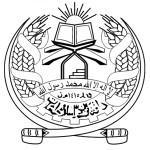Click here for the first part in this video series.
—
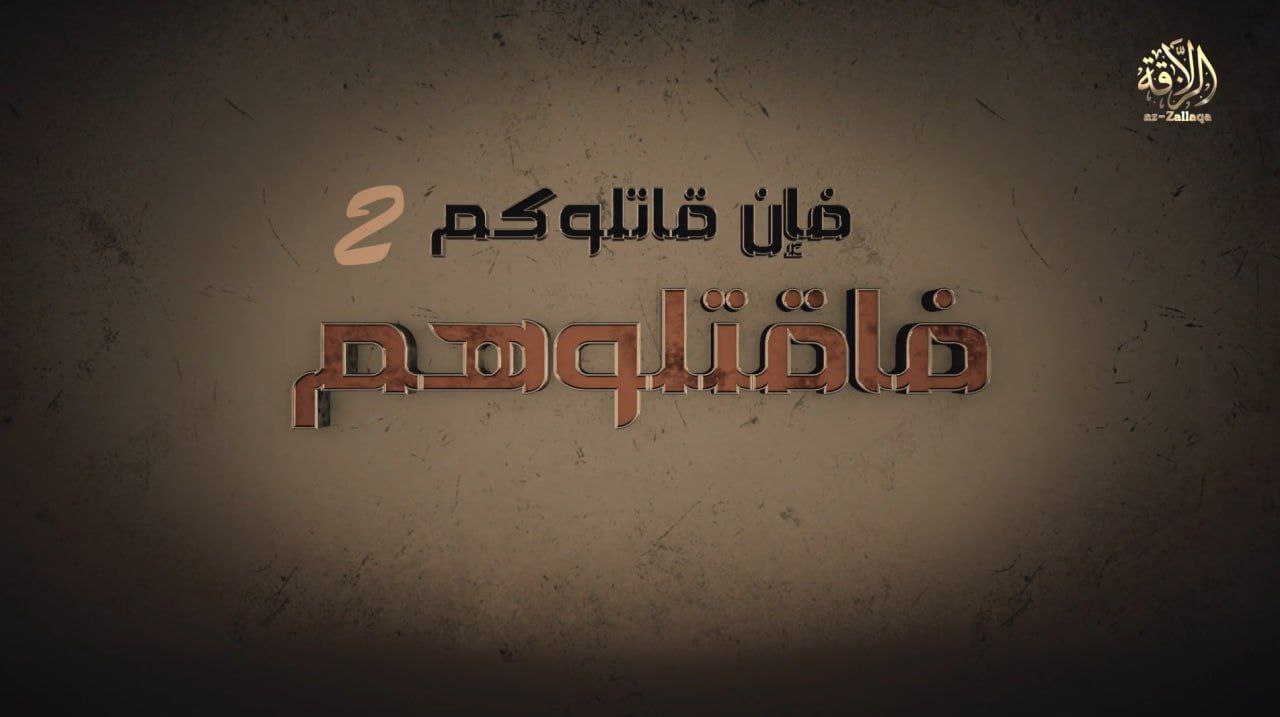
________________
Source: Telegram
To inquire about a translation for this video message for a fee email: [email protected]
Click here for the first part in this video series.
—

________________
Source: Telegram
To inquire about a translation for this video message for a fee email: [email protected]
The title of this release is in reference to Qur’anic verse 2:191. Here it is in full: “And kill them wherever you overtake them and expel them from wherever they have expelled you, and fitnah is worse than killing. And do not fight them at al-Masjid al- Haram until they fight you there. But if they fight you, then kill them. Such is the recompense of the disbelievers.”
—

_______________
To inquire about a translation for this video message for a fee email: [email protected]
—

Arabic:
English:
______________
Source: Telegram
Jihadology.net aims to not only provide primary sources for researchers and occasional analysis of them, but also to allow other young and upcoming students as well as established academics or policy researchers to contribute original analysis on issues related to jihadism. If you would like to contribute a piece, please email your idea/post to azelin [at] jihadology [dot] net.
This is a unique post as it is authored by one of the founder of Jabhat al-Nusra, Saleh al-Hamawi, who has since left the group. Therefore, it is an interesting perspective from someone has previously been a part of the movement on these intellectual issues.
Click here to see an archive of all guest posts.
—
Intellectual Differences and the Future of the Taliban, al-Qaeda, ISIS, the Hay’at Tahrir al-Sham
By Saleh al-Hamawi
Ideology is the effective fuel and the main engine for jihadi groups. There was no comprehensive doctrinal approach adopted by these groups. Rather, it is a set of legal and doctrinal rulings. These groups added the specificity of their temporal and spatial circumstances to later form their intellectual system. ISIS and al-Qaeda emerged from the womb of jihadist salafism, which was not one of the integrated Islamic sects, but began to crystallize after adopting groups that were taking jihad as a path to rule by the Salafi doctrine in the mid-1970s, such as the Egyptian Islamic Group and the Jihad Movement, followed by a long list of organization — the most famous of which are al-Qaeda and ISIS.
As for the Taliban, it emerged from another niche that has no connection whatsoever with the Salafi movement, namely the Deoband school, which adopt the Maturidi creed and the Hanafi school, while jihad is rooted in the instinct of the Afghans and their hatred of the foreign invader that does not require a doctrinal approach to adopt it.
The Salafi-jihadi approach developed during three decades through the accumulation of jurisprudence begun by Salim al-Murjan (an Egyptian) in his book The Clarity in Problems of Infidelity and Belief.
Then the interpretations of the Jordanian Abu Muhammad al-Maqdisi in his book Millat Ibrahim and Between Two Approaches to Abu Qatada al-Filistini in the early nineties. Then, there is the book The Collector of the Noble Knowledge, which is considered the most comprehensive reference to jihadi salafism by Sayyid Imam Sharif (an Egyptian), known as ‘Abd al-Qadir ‘Abd al-‘Aziz. He later would retract this approach in 2008 in the so-called document Rationalizing Jihadist Action from inside Egyptian prison. This forced his former deputy in the jihad movement, Ayman al-Zawahiri, to respond to him in his book The Exoneration of the Nation of the Pen and the Sword From the Defeat of Cowardice and Weakness. Briefing the Salafi-jihadi approach with the following principles:
As for the Taliban, they do not adopt any of that. Rather, they believe that everyone who bears witness that there is no god but God and Muhammad is the Messenger of God is a Muslim. And this does not prevent fighting their opponents, but the cause of the fighting is oppression, not infidelity, as in their fight against Ahmad Shah Mas’ud between 1996 and 2001, as a transgressive group that emerged. In contrast, we find that al-Qaeda assassinated Mas’ud because of his apostasy from religion, as they accused him of being an agent of France and the West.
As for ISIS, it has become a more extreme version of al-Qaeda. Its founder, Abu Mus’ab al-Zarqawi, was not accepted by al-Qaeda in its camps in 1999 in Kandahar, due to his extremism, according to what al-Qaeda’s Secretary-General Fadil Harun reported in his book The War on Islam, so he chose the city of Herat, bordering Iran, to establish his camp there. Al-Zarqawi chose Abu ‘AbduAllah al-Muhajir al-Masri as a legitimate reference for him (the author of the book Issues in the Jurisprudence of Jihad), which laid down rules for all the actions of ISIS that we saw in 2013, such as burning and brutal methods of execution.
The most prominent differences between al-Qaeda and al-Zarqawi’s group (called Jama’at Tawhid wa-l-Jihad at the time) was the infidelity of all Shi’ites, scholars of regimes and Islamist parliamentarians, while al-Qaeda does not declare all Shi’ites to be infidels, only its senior scholars. Likewise, they strategically differed on the issue related to fighting the near enemy (Arab regimes) versus fight the distant enemy (the interests of America and Israel only).
Despite these differences, a political marriage took place in 2004 between al-Qaeda and Jama’at al-Tawhid wa-l-Jihad in Iraq. It took place because al-Qaeda needed a moral victory after many of its leaders were killed or arrested after the U.S. invasion of Afghanistan and al-Zarqawi needed access to al-Qaeda’s financial network. Abu Hamzah al-Muhajir (whose real name is ‘Abd al-Mu’naym al-Badawi, a former companion of al-Zawahiri) succeeded in bringing the two sides closer together, and the pledge of allegiance was made in 2004.
After the killing of al-Zarqawi and the announcement of Abu Hamzah al-Muhajir of the Islamic State of Iraq on October 13, 2006, the extremism of their soldiers increased and they began to fight all those who defected from them, did not pledge allegiance to them, considered themselves to be the group of Muslims (the Islamic State), not a small group of Muslims, and they declared apostasy on all those who oppose them from the Islamic groups and parties until they got to the version we saw in 2013.
=&0=&:
It was a branch of the Islamic State of Iraq and adopted its entire approach until 2014, when it began to differentiate a little from it, not in the ideological approach, but in the field of legitimate politics, such as not declaring the infidelity of those who adopt democracy from the Islamic parties and scholars of Arab regimes. They also differed with it in the legitimate ruling of allegiance, for ISIS believes fighting whoever did not pledge allegiance to it, while al-Nusra believes that one is only a sinner. As a consequence, al-Nusra tried to curb its elements and prevent them from engaging in the issues of apostasy on others and educated them about the necessity of separating from al-Qaeda as the legitimate interest of the jihad in al-Sham, which eventually happened on July 28, 2016. Though the real reason for the split was al-Zawahiri’s decision to isolate Abu Muhammad al-Jawlani, the original founder of al-Nusrah, and appoint Abu al-Khayr al-Masri the leader of al-Nusrah. Abu al-Khayr only entered Syria in 2015 after coming from Iran when he was released from its prisons in a deal between al-Qaeda in the Arabian Peninsula and Iran. Abu al-Khayr was eventually killed by the international coalition with a done raid on February 17, 2017 in Idlib City. Because of al-Zawahiri’s attempted maneuvers, al-Jawlani took a proactive step, disassociated himself from al-Qaeda and changed its name to Jabhat Fatah al-Sham and then later Hayat Tahrir al-Sham. HTS began with a series of openings and tactical changes in its curriculum due to local and regional conditions, such as Russia’s invasion of Syria and the spread of Turkish forces and the need for HTS to remove its classification from terrorism lists. However, more than 60% of its members still adopt the approach of Jabhat al-Nusrah.
=&1=&
At the time Usamah Bin Ladin announced the Global Front to Fight the Jews and the Crusaders in 1998, he was under the command of the Taliban and pledged allegiance to them. Yet, under their protection, direct friction began between the Taliban and the men of al-Qaeda, where the organization committed all its elements to the obligation of jihad against Ahmad Shah Mas’ud’s Northern Alliance in obedience to the ruler, Mullah Muhammad ‘Umar. Al-Qaeda legislators began to engage in dialogues and debates with Taliban scholars on basic issues of beliefs such as ruling by other than what God has revealed, allying unbelievers against Muslims, supporters of tyrants, and martyrdom operations, which the Taliban considered suicide operations.
Al-Qaeda was not able to make a legitimate change in the Taliban until 2001, when the rule of the Islamic Emirate of Afghanistan fell after the American invasion, and the withdrawal of the Taliban to the mountains with the remnants of Al-Qaeda. Following al-Qaeda’s assassination Ahmad Shah Mas’ud, the Taliban saw the Northern Alliance’s dealings with the Americans, and it began to adopt their views on apostasy. They now accuse Muslims of infidelity, which was not the case in 1990s.
These intellectual changes continued until 2009, when the Taliban began to control some districts in Afghanistan. That is until there was an infiltration of an ideological current of some of its fighters from the second and third rank and some leaders of the first row represented by the Haqqani Network. They adopted the ideas of apostasy for those who practice democracy. The Taliban was unable to control this current. Part of this was because the intellectuals within its ranks were more preoccupied with fighting America. As a consequence, the snowball grew and became a large current of extremism embodied by an eventual split from within the movement and the pledge of allegiance by some to ISIS in 2013. All of them were Afghans, and this was confirmed by Zabihullah Mujahid, the official spokesman for the Taliban, in a statement to Anadolu Agency.
After the split to ISIS from the Taliban, a wing within the movement remained adopting a large part of the al-Qaeda’s approach embodied in the Haqqani Network with their adherence to the Maturidi doctrine and the Hanafi
—

________________
Source: Telegram
To inquire about a translation for this video message for a fee email: [email protected]
—
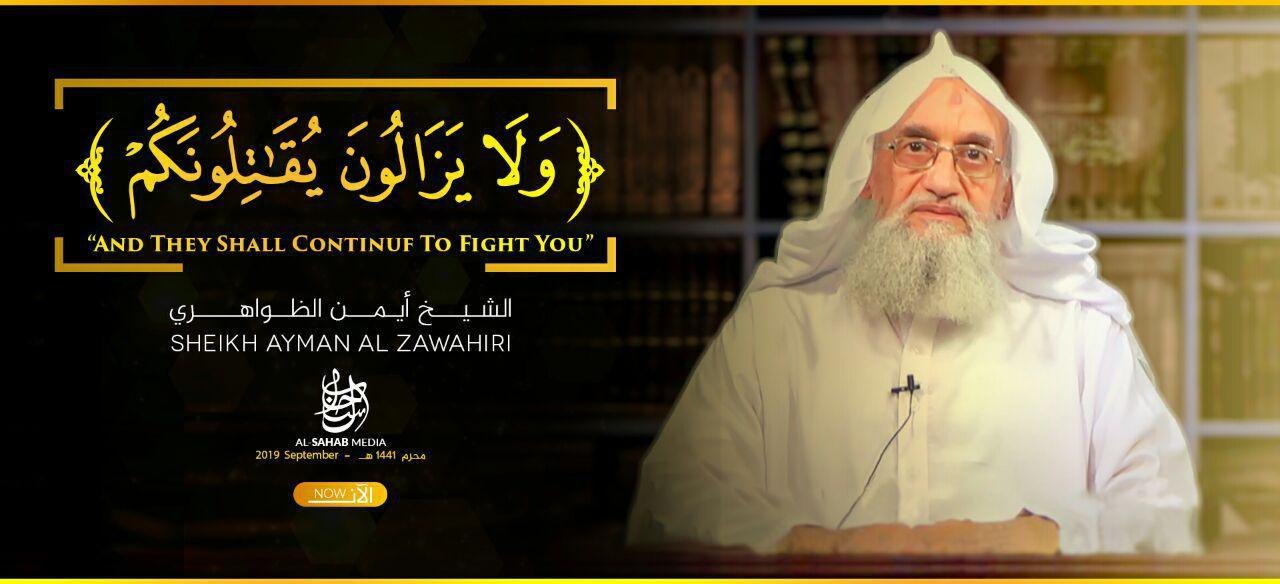
Video:
English Translation:
Dr. Ayman al-Ẓawāhirī — And They Will Continue To Fight You (En)
_________________
To inquire about a translation for this video message for a fee email: [email protected]
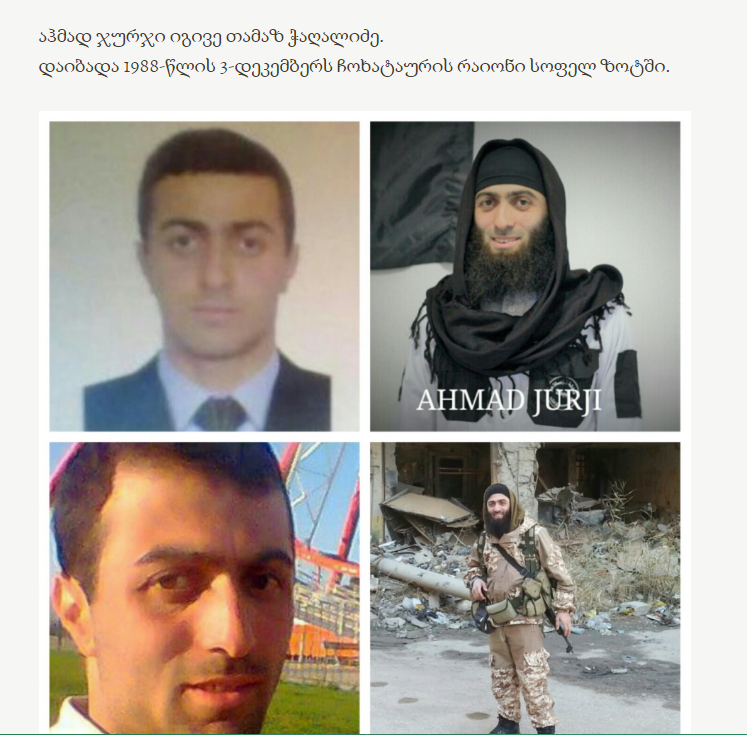
“Attention- to the kaafirs in Georgia who did anything against Islam and Muslims as part of NATO missions in Iraq, Afghanistan, Africa,8 or in Georgia itself in Lapanquri,9 Pankisi, Guria, Adjara, Javakheti or other regions. We know all your actions and you will pay for everything with your dirty kaafir blood. I warn you again- do not touch any Muslim brother or mosque or anything that concerns the name of Islam; otherwise, one day, when the black flags fly over Georgia, you will have nowhere to escape. You will beg on your knees, and they will show it on TV programs. You rats will regret the day you were created. We will cause so much trouble for the Patriarchate in Adjara that you robe-wearing rats10 will wish you were created as reptiles. I swear, by Allah, every kaafir will pay with their dirty blood. The one chance that civilians have is to accept Islam and pledge allegiance to the Caliphate.”
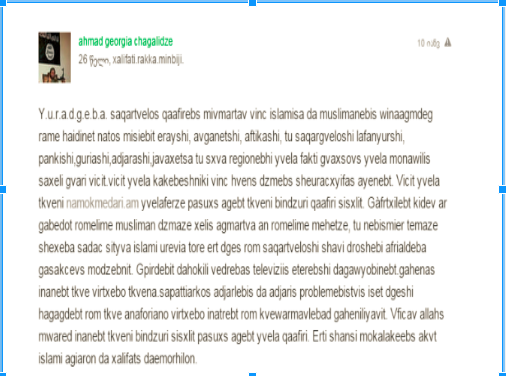

To inquire about a translation for this video message for a fee email: [email protected]
Little is left of the Islamic State’s territorial control, which, at one point, stretched from Aleppo, Syria to Fallujah, Iraq. The intensification of the 60 nation coalition’s effort to defeat the Islamic State has borne fruit, regaining control over key urban strongholds, such as Raqqa and Mosul. Yet, with the degradation of Islamic State territorial control, European nations may face an influx of returnees. The international intelligence and security community has already indicated that, while the IS’s territorial control may cease to exist, it is highly likely that IS as an underground terrorist organization will continue its jihad against Middle-Eastern and Western targets. Not only do they fear that returning fighters have, while in the trenches, adopted the radical anti-Western ideologies of their jihadi peers, but also that they would return to European soil, heavily traumatized and familiar with a wide range of heavy weaponry and explosives. The fact that the 2014 shooting at the Jewish Museum in Brussels, the November 2015 Paris attacks, and the 2016 Brussels bombings involved returned operatives appears to confirm this.
With at least 6,800 European nationals fighting in Syria and Iraq1, and estimates suggesting that approximately a quarter – nearly 2,000 – have already returned, the risk is not insignificant. Monitoring these returnees has added significant strain to European intelligence and security services. Closer examination of the available data shows a variance in the number of returnees per country. A (rough) distinction can be made between Northern and Southern European countries (see figure). While countries such as Italy (10.5%, 13/124), France (14.2%, 271/1910), and Spain (14.7%, 30/204) are facing relatively low percentages of returnees, countries such as Denmark (49.6%, 67/135), the United Kingdom (50%; 425/850), and Finland (53.8%; 43/80) have a significantly higher share of jihadi foreign fighters returning. Where does this variance stem from?
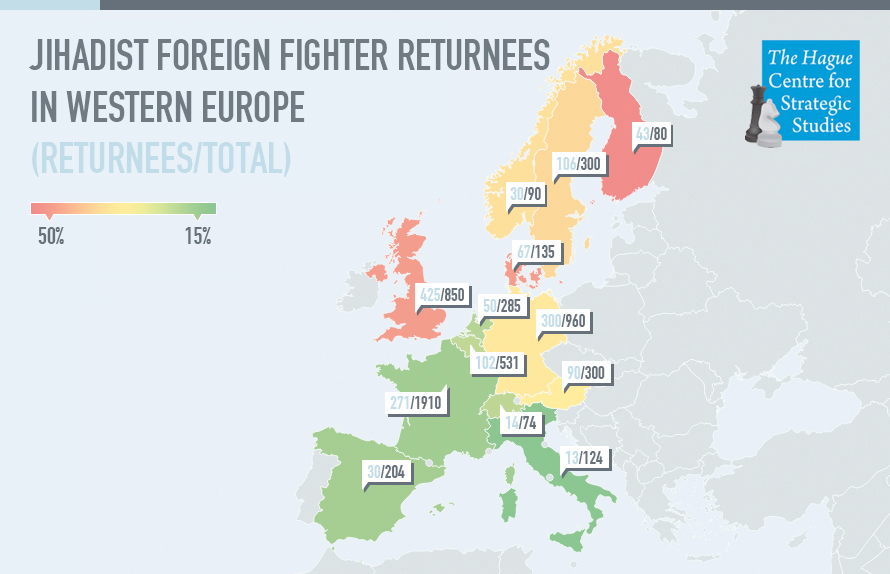
FIGURE 1. JIHADI FOREIGN FIGHTER RETURNEES IN WESTERN EUROPE (RETURNEES/TOTAL)
First, there is a difference in terms of approach between the mostly Southern European countries on the one hand and the Northern European, especially Scandinavian, countries on the other, with the latter tending to focus much more on the reintegration and rehabilitation of returnees. This soft approach may lower the threshold for disillusioned jihadis that are hoping to return to their home country.2 In Sweden, authorities have experimented with housing, employment, education, and financial support, with the aim to reintegrate returnees back into society.3 The Danish so-called ‘Aarhus model’ aims at disengagement, offering returnees a second chance.4 On the other end of this continuum, the prospects of returning to normal life in countries taking a more repressive approach are significantly limited, given the probability of severe penalties upon their return. For example, France, with a significantly lower share of returnees, takes a much more repressive approach, as it is capable of stripping fighters from French nationality, revoking passports, and/or sentencing them to long jail terms.5 The Pontourny Center, France’s first, and only, deradicalization program closed its doors in August 2017.6 In Italy, administrative deportation of foreign suspects is a common measure: since early 2015, the authorities have deported more than two hundred individuals deemed a threat to national security.7
Second, apart from the perspectives upon their return, there is a distinction to be made in terms of national approaches in facilitating return journeys. Danish foreign fighters wishing to return to their home country are actively repatriated, a tactic that fits its inclusive approach.8 The Netherlands requires its nationals to report to a Dutch embassy or consulate, before they acquire the right to be repatriated.9 This requirement makes it inherently difficult to return, given the limited possibilities of free and safe travel in Syria and Iraq. Additionally, passports and travelling documents were oftentimes confiscated by IS upon arrival in the Caliphate, or sometimes deliberately burned by the fighters themselves, making travel even more difficult. Other countries simply refuse to repatriate its citizens, as they suggest jihadis should be tried or even killed abroad.10
Third, in an attempt to prevent fighters from returning, several countries, including France and the United Kingdom, but also the United States, have formulated a hit list, deliberately targeting their own nationals, aiming to eliminate them and thereby prevent them from returning. Although such extrajudicial killings are obviously far from undisputed, they prefer a dead jihadi over a captured one – a notion that is shared by countries without such a list.11 Although not all countries have formulated such a hit list, it is possible that these countries provide crucial intelligence that may lead to the targeted assassination of its own nationals. The Netherlands, for example, could provide intelligence to its coalition partners, that may contribute, directly or indirectly, to the targeting process.12
Fourth, although there is limited data available on the European level, and the lion share of returnees were part of IS (in Belgium: 64/353; 18.1%), data on the Belgian sample shows that the relative share of returnees who were members of the Al Qaeda-affiliated Jabhat al-Nusra (14/55; 25.5%) seems to be bigger.13 Although there is no similar data available for the Netherlands, approximately twenty jihadis returned before IS became a player in Syria, potentially implying a similar process at work.14 This seems to be in line with the general belief that IS tends to be significantly more repressive when it comes to fighters attempting to leave their ranks.15 (Suspected) defectors are generally considered as spies or traitors, resulting in execution.16 Hence, a possible explanation for the different numbers of returnees may lie in the different policies of the organization the jihadis have joined. This hypothesis requires further exploration.
So far, a higher share of returnees has not necessarily translated into more terrorist attacks. The 2014 shooting at the Jewish Museum in Brussels, the November 2015 Paris attacks, as well as the 2016 Brussels bombings were conducted by returnees of French and/or Belgian origin. Moreover, the perpetrators of these attacks returned to Europe under the radar of the European intelligence and security community. It is unclear how many jihadis – with or without malicious intent – have returned to Europe beyond the gaze of intelligence and security services. So far, the number of returnees that was involved in terrorist attacks in Europe has been limited. Yet, given their vast number, they represent a significant security challenge for their home countries. Even with the so-called Islamic State collapsed, the conflict in Syria and Iraq has provided a new impetus to global jihadism for years to come.
Reinier Bergema is a Strategic Analyst at The Hague Centre for Strategic Studies and Colonel RNLAF (ret.) Peter Wijninga is a Subject Matter Expert in Defense & International Security at The Hague Centre for Strategic Studies
Notes
__________
1 See: https://dwh.hcss.nl/apps/ftf_monitor/#section-ftf-total
2 Charles Lister. Returning Foreign Fighters: Criminalization or Reintegration? (Doha: Brookings Institution, August 2015). Retrieved from https://www.brookings.edu/wp-content/uploads/2016/06/En-Fighters-Web.pdf
3 Lizzie Dearden, “Swedish city to offer returning Isis fighters housing and benefits in reintegration programme”. Independent (October 20, 2016). Retrieved from https://www.independent.co.uk/news/world/europe/sweden-isis-fighters-city-lund-returning-jihadis-housing-job-education-benefits-reintegration-a7371266.html
4 Alastair Reed & Johanna Pohl. Tackling the Surge of Returning Foreign Fighters (The Hague: International Centre for Counter-Terrorism (ICCT), July 2017). Retrieved from https://icct.nl/publication/tackling-the-surge-of-returning-foreign-fighters/
5 Piotr Bąkowski & Laura Puccio. Foreign Fighters – Member state responses and EU action [Briefing]
(Brussels: European Parliamentary Research Service (EPSR), March 2016). Retrieved from
